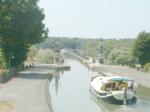Before There Were Trucks, There Were Railroads, ... Before There Were Railroads, There Were ...

A picturesque canal

... canals. I once had the opportunity to take a flatboat ride along a section of restored canal in central Ohio. Horses on the bank of the canal, the towpath, pulled a merry band of sightseers and history buffs along for a mile or so before turning around and returning us to our point of departure. Reliving history for a pleasant hour or so was enjoyable and educational. For people living in the pre-Civil War era, however, canals boosted economic development by providing a cheap transportation route for selling their goods over a wide area.
When I think of canals, I think of the northeastern states, like New York. It's good to know that some of the old canals are still around, even if their economic significance is diminished. Down south, where I grew up, canals weren't necessary because of navigable rivers, and because the iron horse was a more economical delivery system for goods by the time population levels reached critical mass in the south.
In Europe, the old canals seem to be alive and well. According to this information, several canals are still classed as working canals in Scotland. There seem to be a lot of canals in Britain.
Canal digging goes back a long way in history. In fact, economic historian Robert Fogel recognized the importance of canals in pre-civil war America:
Had the railroads not been invented, shipments would have taken place via canals, rivers, and wagons. Wagons being expensive and inefficient, they would have been useful only for short hauls to rivers or canals. Fogel concluded that the costs of wagon transport would have made agriculture economically feasible no more than roughly forty miles from any navigable waterway. Based on the system of canals in 1890, both in use and previously abandoned, Fogel was able to include 76 percent of all contemporary agricultural land within forty-mile buffer zones adjacent to the system of waterways. Nearly all of the agricultural land that fell outside the buffer zones, and hence would have been lost to the economy, were concentrated in the four states of Illinois, Iowa, Nebraska, and Kansas, meaning that the railroad's impact was felt most in the intraregional trade between farms in those states and the great primary markets of the Midwest.
One thing that hasn't changed in 200 years is that goods have to be transported from producers to consumers. Today, most goods are transported by truck or rail. I doubt that 200 years from now people will consider highways and railroad tracks to be as picturesque as the old canals. Link







1 Comments:
The canals in Amsterdam are really worth visiting. They are still used daily for transporting goods and people--especially tourists. It is easy to imagine what the city looked like 300 years ago (minus the "coffeeshops").
Post a Comment
<< Home